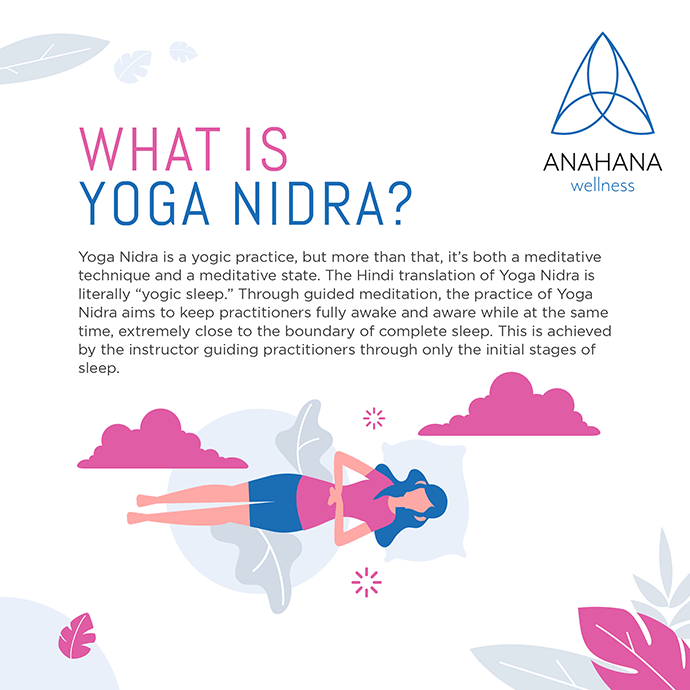
Table of Contents
Yoga Nidra is gaining popularity worldwide, and ongoing global research continues to prove its true effectiveness. It is a powerful meditation technique that relaxes the mind and body.
During the practice, you will rest comfortably in corpse pose (Savasana). Then the teacher will bring you through five layers of the self, known as Pancha Maya Kosha. These steps will put you into a calm and restful state of consciousness where you will experience deep relaxation. The result will leave you with an inner sense of wholeness and gratitude.
With Yoga Nidra, you no longer have to practice meditation sitting upright on the floor. Continue reading to learn how this easy meditation technique helps you and more!
What is Yoga Nidra?
Yoga Nidra, also known as yogic sleep, is a highly beneficial guided meditation. During a session, your teacher will take you through breathing exercises and body scans. These will draw your attention inward, putting you into a state of consciousness that sits on the border between waking and sleeping. These steps will allow you to reach a deep state of relaxation without falling asleep.
In this passive and active state, our bodies can rest. This allows healing to occur within the body as it resets the nervous system. While we lie in a deep state of relaxation, our minds can focus on being conscious, and we can experience feelings of interconnected wholeness. This state aids in healing the mind and body while awakening our deepest, all-welcoming self.
Who is Yoga Nidra meant for?
All populations can experience the benefits of Yoga Nidra. However, it is particularly beneficial for individuals who face a high level of stress and struggle to let go. In addition, it is also helpful for people suffering from sleep deprivation, trauma, and mental health issues such as anxiety and depression. The sky's the limit when it comes to the benefits you can obtain through this meditative practice. So no matter who you are and what your situation might be, practicing Yoga Nidra can support your health and wellbeing.
How do you practice Yoga Nidra?
 During the practice of Yoga Nidra, a teacher will guide you through the meditation process. You will remain present and at the moment throughout the session as you alter your state of consciousness. The session will usually last between 30 to 45 minutes.
During the practice of Yoga Nidra, a teacher will guide you through the meditation process. You will remain present and at the moment throughout the session as you alter your state of consciousness. The session will usually last between 30 to 45 minutes.
You begin by lying down on your back. Once you are comfortable, you will set your intention for the session - this is called your Sankalpa. For example, yours might be “my heart is open and relaxed” or “I let go of what was, I accept what is, I manifest what will be.” This intention will be revisited throughout the session.
Following this, you form a foundation by connecting to your body through a multi-sensory reflection, making you feel safe and secure. You will shift your focus to the body and breath through guided exercises, helping establish sensory awareness. This step leads the body and mind into a deep state of relaxation. During this phase, emotions and experiences from your subconscious will often emerge. However, sleep meditation puts your body and mind in neutral, helping you welcome and respond to the arising thoughts and feelings effectively and in new ways. This unique conscious experience allows you to confront uncomfortable memories and come to a new understanding. This part of the exercise uses yogic techniques, including experiencing opposites, to deepen the state of relaxation. Once you become aware of the emotions and see them in a new light, they will become increasingly subtle.
You now enter the final phase of the exercise, where you explore consciousness. Here, you can recognize your true self. This is the highest realization you will come to during the practice. As we near the end of the session, you will repeat your initial sankalpa three times, then mentally prepare to return to ordinary consciousness. Begin by moving your fingers and taking a deep breath. Then slowly open your eyes.
How does Yoga Nidra work?
There is a science behind the extensive benefits of this meditative practice. The process moves systematically through the body using what psychologists call habituation. This means that meditation works by using repeated stimuli to provoke a response in the mind and body. By bringing awareness to sensations in the body, you become habituated and forget about senses from the outside world. This helps you focus your attention inward.
The visualization part of the exercise aims to expose painful memories, fears, and emotions. This part of the exercise is known as brain plasticity, which works against existing neural pathways to reinforce new ones. This creates space for the brain to adjust negative thought patterns and habits. In addition, the practice corrects physical and mental imbalances while treating anxiety, depression, addiction, PTSD, and much more. Here, you can access your subconscious to become aware of your inner thoughts and feelings. Once you connect your mind to your emotional tension, you can release the pain and begin healing.
To summarize…
Yoga Nidra is a meditative practice. However, it is far more than just that. It utilizes ancient yogic techniques to benefit students profoundly. People of all ages and backgrounds can improve themselves through Yoga Nidra practice. Whether you struggle with a sleeping disorder, want to regulate your emotions, or are looking to improve your health and wellbeing, Yoga Nidra may just be the answer you are looking for.
What are you waiting for? Start your journey to self-improvement today with this ancient practice. Yoga Nidra done regularly will improve your daily life in just a short amount of time.
Disclaimer
As with any type of exercise, yoga does not come without its own risks. Practicing yoga should be done with care and respect, reducing the risk of injury.
If you are suffering from any medical conditions or are unsure which type of yoga or exercise is best suited for you and your conditions, we advise you to consult a medical professional or your doctor.
References
Effects of a Yoga Nidra on the life stress and self-esteem in university students - ScienceDirect
Full article: Yoga-Nidra and hypnosis


By: Anahana
The Anahana team of researchers, writers, topic experts, and computer scientists come together worldwide to create educational and practical wellbeing articles, courses, and technology. Experienced professionals in mental and physical health, meditation, yoga, pilates, and many other fields collaborate to make complex topics easy to understand.
